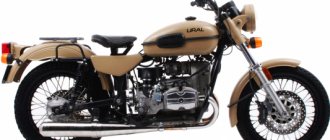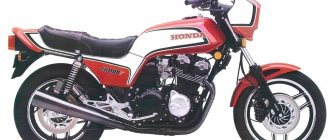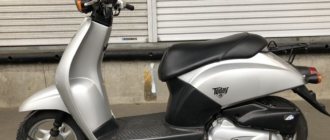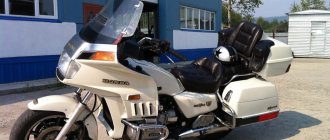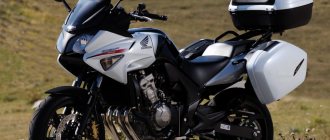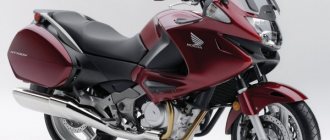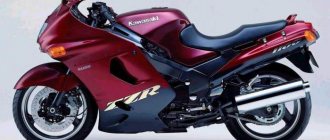For whom
Here are the main features of the Honda CB 1100:
- the shape of the car corresponds to the classics of the eighties;
- despite the old-fashioned style, there are versions with ABS;
- The motorcycle has a high degree of convenience for a retro classic.
The bike is suitable for a wide range of motorcyclists, among whom there may be both experienced riders and not very confident drivers. This is not a machine for speed and competition, this is a motorcycle for leisurely riding on a good road.
conclusions
If we evaluate these motorcycles from the position of “purchase for centuries” for their use specifically as a vehicle, then Honda will have an advantage due to more thoughtful ergonomics, smoothness of the engine, comfortable suspension and greater versatility, allowing you to ride around the city every day, and go on a long journey. You can spend 12–14 hours without a break behind the wheel of a Japanese motorcycle and travel one and a half thousand kilometers from home in a day.
BMW is not so merciful in this regard - its driving position is more tense, and the seat is so comfortable, and it itself is more twitchy and rigid, which makes it more tiring on a long journey. Its element is driving in the city and near suburbs, where its sharpness in acceleration and trajectory changes will encourage you to drive aggressively and quickly.
From an image point of view, Honda has high value only in its home country, while BMW has high value throughout the world. If you care about the opinions of others, then it is better to choose BMW. There are still people alive who remember the “economic miracle” of Japan, which after World War II flooded the whole world with cheap goods of dubious quality. After it, South Korea did roughly the same thing, and now China is doing it with all its might. Can we talk about the legendary nature of Geely or Great Wall cars? Definitely not yet, and many years must pass until the “no” is replaced by a definite “yes”, and then only with the constant impeccable reputation of their products. Honda's reputation is fine, but BMW is older and actually stood at the origins of European motorcycling.
As you can see, there are enough differences between these bikes to make your choice easier. You need to grow into the paradigm of long-term use of a vehicle and then decide what suits you best in terms of design, brand and feelings awakened in your soul, and also take into account your style of behavior on the road.
The BMW motorcycle was provided for testing by the BMW Motorrad representative office in Russia.
www.bmw-motorrad.ru Honda motorcycle provided for testing: www.honda.co.ru/motorcycles Tverdynya > February 1, 2019 08:40 Denis DEAN Panferov
Engine
The motorcycle is equipped with an in-line, four-stroke and four-cylinder engine. The unit has air-oil cooling, and its effective volume is 1140 cm³. At the limit of its capabilities, the engine produces a torque of 92 Nm and a power of 87 hp. The maximum speed of the CB 1100 is 220 km/h, and it will accelerate to hundreds in 3.7 seconds.
Honda CB1100. Iron nostalgia
The global trend in the production of motorcycles today is the production of entry-level and small-sized urban vehicles, easy to use and design, but fashionable and aggressive in appearance to appeal to young people
Natalya Umnova
Honda CB1100. Price: from 474,700 rub. On sale: since 2013. The global trend in the production of motorcycles today is the production of entry-level and small-sized urban vehicles, easy to use and design, but fashionable and aggressive in appearance, so as to appeal to young people. Honda does not lag behind its market comrades in this, but does not forget about the origins, as well as the more respectable and solvent part of the audience - accomplished adults.
I park in the long-awaited new classic Honda CB1100, which recently arrived in Russia. The security guard looks at the motorcycle for a long time, then asks: “Is it new or is it so well preserved?”
The question is logical: the retro look of the new “Sibhi” makes many Russians nostalgic for childhood, their father’s garage and the famous two-wheeled vehicles from Czechoslovakia and IZhi with them. Although, of course, the SV1100’s origins do not come from Europe: the SV family appeared at Honda in 1969 with the release of the iconic SV750K0 Four, the first production motorcycle with an in-line 4‑cylinder engine. Its form factor has become the standard for powerful large-capacity motorcycles for many years.
Honda designers managed to create a modern motorcycle in a retro style so that not a single detail stands out from the whole image. Photo: Honda
The new Honda CB1100 is a fusion of tradition and modern technology, a tribute to a cult and a captured moment in history. A classic tank, a headlight, instrument glasses, deep metal fenders, an abundance of real metal and chrome in details, 18‑inch wheels, a classic rear suspension design (a pendulum and two shock absorbers located on the sides), an “air vent” engine—this vintage façade frames quite advanced solutions: a large-volume modern engine, electronic fuel injection, a combined anti-lock braking system C-ABS.
Honda CB1100. Photo: Honda
The beautiful, impressively sized 4‑cylinder in-line engine with a volume of 1140 cm3 and air-oil cooling is located so that it noticeably protrudes beyond the dimensions of the frame. This original solution, for the sake of beauty and style, endowed the CB1100 with its only two drawbacks: the driver is constantly in “grill” mode - the hot engine burns and even burns the legs, even through the pants, and the raincoat “immediately tears into pieces”, and it is not clear how the protruding cylinder heads will be affected by the motorcycle falling.
However, the device will do its best to help you avoid falls. The locomotive mode is activated from the very bottom: in first gear you can drive without gas at all. And at 7-10 thousand rpm, the SV1100 becomes almost a sports equipment, demonstrating very playful dynamics... and a healthy appetite. It turns out to be a 2-in-1 motorcycle: lovers of classics and choppers will appreciate the smooth, economical ride at low speeds, and those who want to rock out won’t get bored either.
The chief designer of the SV1100 project is convinced that “the only liquid in the engine should be motor oil, not water.” Photo: Honda
Well-tuned suspensions and a combined braking system provide the SV1100 with stability on a straight line and in corners. A short wheelbase, correct steering column geometry and rear view mirrors attached to the steering wheel make it easy to maneuver in heavy traffic. A fairly soft and wide seat provides the necessary comfort for moving around the city, but this motorcycle is still not suitable for long distances: there is no wind protection, it starts to blow away at high speeds, the fifth point becomes numb after a few tens of kilometers, and you can’t stretch your legs to relax.
But such motorcycles are not bought for practicality and convenience, although riding around the city on the SV1100 is truly a pleasure. This motorcycle is the embodiment of style, a nostalgic concept confirmed by serious technical characteristics, which also rides great - an ironclad argument for the iron Honda CB1100.
Technical characteristics of Honda CB1100
| Dimensions | 2195x835x1130x795 mm |
| Base | 1490 mm |
| Fuel tank volume | 14.6 l |
| Engine | 1140 cm3, 4-cylinder, in-line, 4-stroke, air-oil cooled, injector, 89/8500 hp/min-1, 93/5000 Nm/min-1. |
| Transmission | 5-speed manual gearbox, multi-plate clutch in oil bath, drive - chain |
| Frame | steel, duplex |
| Front suspension | telescopic plug, setting |
| Rear suspension | pendulum, 2 shock absorbers, adjustable |
| Brakes (front/rear) | hydraulic, 2 discs / 1 disc |
| Dry weight | 228 kg |
Honda CB1100. Photo: Honda
Between the two vintage glasses of the speedometer and tachometer there is a small on-board computer display. Photo: Honda
Honda CB1100. Photo: Honda
Under the seat: manual, tools, glove compartment. But you can’t immediately figure out how to remove the seat - it’s written in the manual, but it’s under the seat. Hint: the lever under the helmet hook. Photo: Honda
Honda designers managed to create a modern motorcycle in a retro style so that not a single detail stands out from the whole image. Photo: Honda
Honda CB1100. Photo: Honda
The editors recommend:
How to reduce washer fluid consumption?
Russians will be able to catch traffic violators on their phones
Where is it better to store a car - in a garage or outside? Opinions for and against
Advanced truck driver and savings on service: what do cargo carriers rely on?
New law: fine drivers for speeding 5 km/h
News Media2
Discussion Cancel
I want to receive the most interesting articles
Dimensions and weight
The bike reaches 1100 mm in height, 800 mm in width, and 2180 mm in length. The wheelbase is 1485 mm, and the seat height is 785 mm. Together with fuel, the bike will weigh 252 kg, and its tank volume will be 16.8 liters. The average consumption per hundred will be approximately 4-5 liters.
Chassis and brakes
The steel frame CB 1100 is duplex in type. The motorcycle is equipped with alloy wheels. This doesn't really fit into the retro style framework, according to some, however, given that the bike still imitates the designs of the eighties, and not the sixties, it is appropriate. The steering wheel is typical for the class.
The rear suspension is a pendulum version with a pair of shock absorbers with remote reservoirs. At the front, this role is played by a 43 mm telescopic fork. Braking at the rear is a two-piston caliper and 256 mm disc, while at the front there are two 310 mm discs with four-piston radial calipers.
Construction of the CBR1100XX Blackbird
Among the design features of the Honda CBR 1100 XX, the spatial aluminum frame should be highlighted.
Since the model was positioned as super fast, the developers had virtually no choice in frame material. Only aluminum could provide the necessary rigidity for a sports tourist, and at the same time, the lightness of the structure . Thanks to this, the bike should have good maneuverability, and controllability and speed resulted from the spatial layout of the assembly and the large amount of electronics that were planned to be used in development.
- To improve safety in the suspension, no innovations were applied. The front wheel was held by a telescopic fork (the thickness of the stays is 43 mm ), the rear wheel was held by a mono-shock absorber on a pendulum mount . The travel of the front springs was 109 mm , the rear - 120 mm . The only new solution was the ability to adjust the rebound. Changing the preload was proposed on the previous sports tourer .
- In addition to a large amount of electronics, the motorcycle also received a motor created from scratch, adjustable suspension, combined brakes and much more. Some of the parts were already offered in early development, but most of the new products appeared only after the 1999 restyling, after the Blackbird lost its title of super fast.

